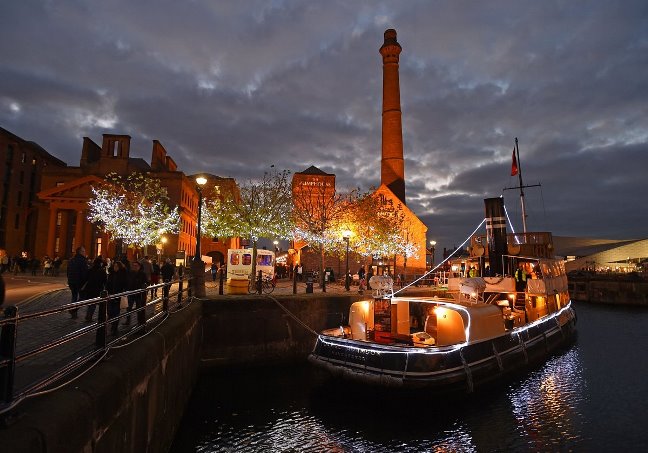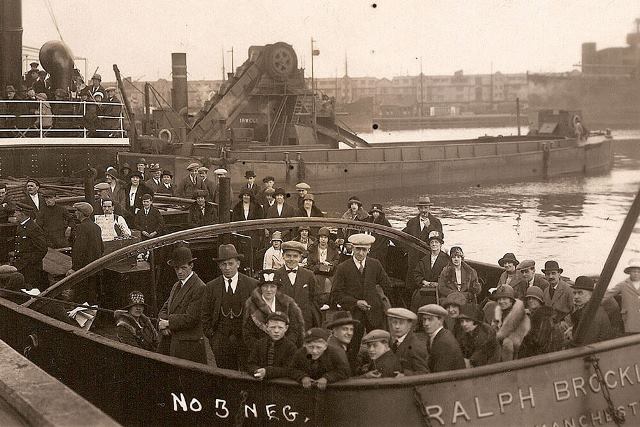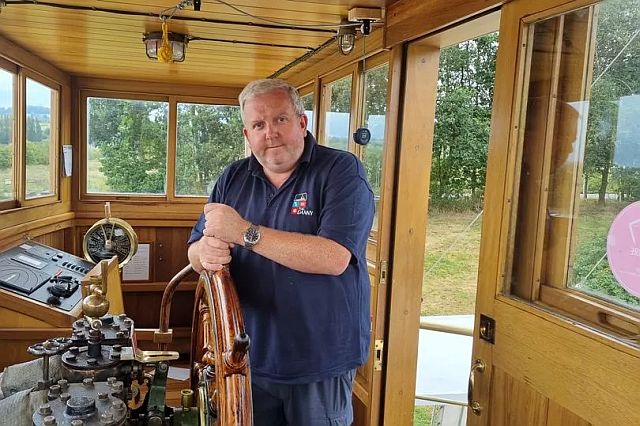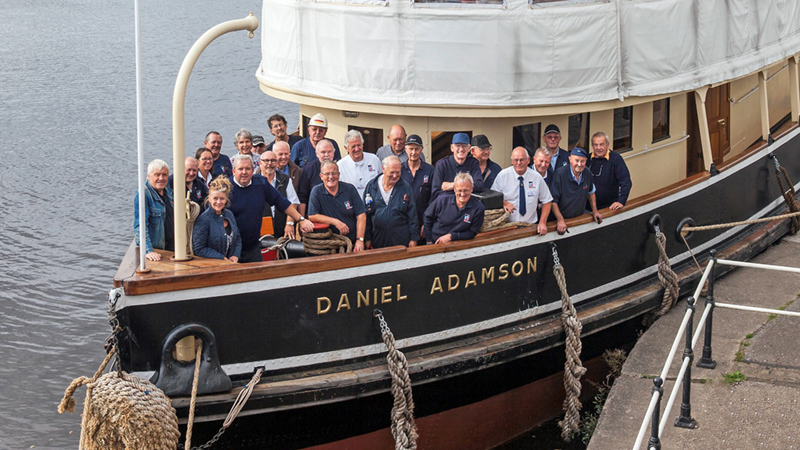Bob Cannell and Les Green
“How to increase productivity.” This is one of the pressing economic questions of our times but it was also a pressing question in 1900 when the Shropshire Union Canal and Railway Company (SUC&R) commissioned a tug boat from the Tranmere Bay Development Co. It was delivered three years later in 1903 and it was designed to tow up to ten barges from Ellesmere Port to Liverpool. We were expecting Sheila Leonard to tell us about the history of this boat and the story of its restoration but in the event Bob Cannell and Les Green came. We thought at first it was confirmation of the old adage that it takes two men to do the work of one woman but it turned out that Bob and Les had always intended to come to Marple. Indeed they had practiced giving this talk on almost two hundred occasions before they felt confident enough to make a presentation to Marple Local History Society.
 The Danny in Liverpool Docks
The Danny in Liverpool Docks
Les started by giving us a history of the boat from its conception. Barges were arriving in Ellesmere Port from the Midlands along the Shropshire Union Canal with products for export but had to cross the Mersey estuary to reach Liverpool. Rather than each barge sailing independently across the estuary which could at times be quite rough, the company decided it would be more efficient to consolidate shipping by towing a string of barges with a single tug boat. The Shropshire Union placed the order with the Tranmere Bay Development Co of Birkenhead, one of the constituent companies of Laird Brothers which soon after became Cammell Laird after merging with Johnson Cammell. The ship was launched in 1903 and given the name “Ralph Brocklebank.” This was obviously a political choice as Ralph Brocklebank was a director of the London and North Western Railway, the owners of the Shropshire Union Canal. At the time the LNWR was the largest joint stock company in the world, so presumably, Mr Brocklebank decided that it was beneath his dignity to attend the launch of a mere tug boat.
 A 1920s cruise of the Danny, note class distinction by headware
A 1920s cruise of the Danny, note class distinction by headware
From its launch until 1915 the tug was engaged in towing barges on the Mersey but in these early days it also carried passengers. After 1915 it only towed freight and in 1923 it was sold to the Manchester Ship Canal as that company was playing an important role with regard to all shipping on the Mersey. It was still used as a tug but it also operated as a cruise boat between Manchester and Eastham that included a return train trip from Ellesmere Port to Manchester. All this for 7/6 (37pence) including lunch. Not just ordinary people but it also hosted kings, sultans, military leaders and other eminent visitors.
In time, carrying passengers became the more important role and removable awnings were fitted to the bridge and stern deck. In 1936 it was given a complete refit, converting it into a luxury passenger vessel with Art Deco furnishing throughout. At this point the company took the opportunity to rename the vessel the “Daniel Adamson” after the driving force behind the Ship Canal and its first chairman. A fitting change, as its original namesake was one of the fiercest opponents of the Ship Canal. Inevitably this new name was abbreviated to “Danny.”
 The Art-Deco interior of Danny
The Art-Deco interior of Danny
The Second World War rudely interrupted Danny’s new career and, although it took off again after the war, its glory days were over. The emphasis changed to becoming a venue for corporate hospitality functions and acting as the company directors’ inspection vessel. It finished its working life in 1986 at the National Waterways Museum in Ellesmere Port. Once there it was merely a static exhibition and became neglected, mainly because of a shortage of finance. By 2004 it was in disrepair and in danger of being scrapped.
At this low point in the vessel’s history, Bob Cannell took over from Les and related the story of the boat’s rescue and revival. The decision had actually been taken to have her broken up. However, a local tug skipper, Dan Cross, discovered this and had a hastily arranged meeting with Peel Holdings. The outcome was that the Danny cheated her appointment with the ship breakers at Garston but there was a long way to go to save her. Dan Cross and Tony Hirst, a former director of the Ellesmere Port Boat Museum formed the Daniel Adamson Preservation Society and bought the vessel from Peel Holdings (the owners of the Ship Canal) for one pound. However, it would need a lot more money than that. Peel Holdings are not universally regarded as philanthropists but in this story they are on the side of the good guys. Other companies too joined in.
 Dan Cross
Dan Cross
Dan Cross’ employer, Sulzer Marine, offered to dry dock the vessel and assess what was needed to be done. Other people and companies came forward with offers of help and money and the Danny was towed to a berth in Liverpool. Here the hull was grit-blasted, repaired and painted, enabling her to gain a 5-year seaworthiness certificate. The first task was to clean out two decades worth of mud and rubbish but word spread and more people joined the project, many of them with specific skills. Particularly useful were original members of the crew who understood the quirky workings of the vessel. The boilers were a particular problem. Although Cammell Laird were involved in the restoration they did not have anyone who had the experience of repairing and restoring boilers of that era. Fortunately one of their retired employees had that expertise and he willingly agreed to supervise the work on that aspect.
In parallel with the actual work of restoration, a concerted drive had to be made to raise funds to pay for that work and a wide variety of sources was tapped. The Heritage Lottery Fund were the largest contributors but spaced over the whole period in a series of grants starting with development funding of £37,000. Many other bodies contributed grants both large and small, often for specific purposes.
 Proud volunteers with 'The Danny'
Proud volunteers with 'The Danny'
All this culminated in what the charity regards as its crowning achievement. It is a part of the National Historic Fleet with the registration number 15, alongside such historical ships as the Cutty Sark and HMS Victory. The Danny is now fully restored and active but she now has to pay her way. She undertakes day cruises on both a regular schedule and on an occasional “For Hire” basis. This work is gradually expanding but is not without problems. Recently the Danny was cruising along the River Weaver but was trapped when there were problems with two swing bridges. Fortunately the Canal and River Trust were able to repair the bridges and bring them back to working order but the delay still cost the Danny about £37,000 in lost revenue.
It was good to hear of a rescue and refurbishment with a happy ending. Let’s hope that all the time and effort that has gone into the Marple Wharf project will be equally successful.

